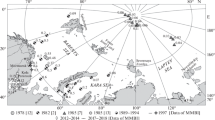Abstract
During a time period little longer than 60 years, it has been created a radioactive pollution background over the natural one, which started in 1945 and it has been growing up since then, due to several nuclear tests, minor nuclear reactors failure and four major accidents: Wind Scale, Three Mile Island, Chernobyl and Fukushima. This radioactive polluting background can be easily detected through 137Cs fission product, which by the effect of wind, river currents and rain has been accumulated in marine sediments, mainly because sea represents about 80 % of earth’s surface. Since energy demand has been growing up with no interruption during last two centuries, and nuclear energy seems to be the largest available source, it is very likely a great expansion of nuclear energy during twenty-first century. So, this paper presents results obtained in strategic points of the two large littorals in Mexico: Gulf and Pacific Ocean, as an attempt to establish there some figure to evaluate the present radioactive pollution. An adequate figure to do it, seems to be the quotient of activity per gram of 137Cs in marine sediments (Bq137Cs/g), divided by activity per gram of 40K natural radioactivity (Bq40K/g). When this result is multiplied by 100 the percentage of polluting radioactivity (137Cs) related to natural radioactivity (40K) is obtained. This percentage seems to be useful to evaluate the importance of radioactive pollution from 4 points of view: a) calculate the extent of already radioactive pollution present in the seas of world; b) avoid the panic in case of nuclear accidents, c) what will be the growing up rate in the future; d) if it is possible to keep one decreasing rate at same decaying rate of 137Cs (t1/2 = 30.07 years), since from 1945, starting time of radioactive pollution, it has decayed only about 2.2 half lives.



Similar content being viewed by others
References
Vazquez A (2001) MSc Thesis, Veracruz University, Env Eng, pp 23–32
Navarrete JM, Müller G (2010) Radioactive contamination research developments. Nova Science Publishers Inc., USA
Lavi N, Groppi F, Alfassi Z (2004) Rad Meas 38:139–143
Rasmussen NC (1980) In: Choppin GR, Rydberg J Nuclear chemistry, theory and applications. Pergamon Press, Oxford, pp 567–569
Acknowledgments
To all the personnel of Sea Science and Limnology Institute, in the National University of Mexico, who have supported this research work.
Author information
Authors and Affiliations
Corresponding author
Rights and permissions
About this article
Cite this article
Navarrete, J.M., Espinosa, G., Golzarri, J.I. et al. Marine sediments as a radioactive pollution repository in the world. J Radioanal Nucl Chem 299, 843–847 (2014). https://doi.org/10.1007/s10967-013-2707-4
Received:
Published:
Issue Date:
DOI: https://doi.org/10.1007/s10967-013-2707-4




